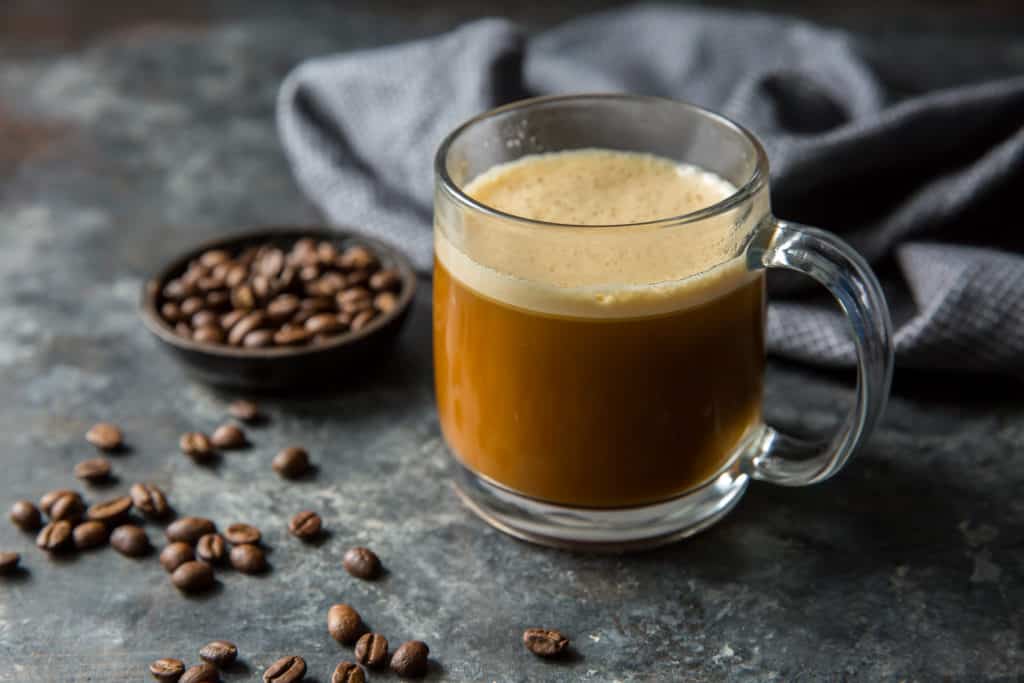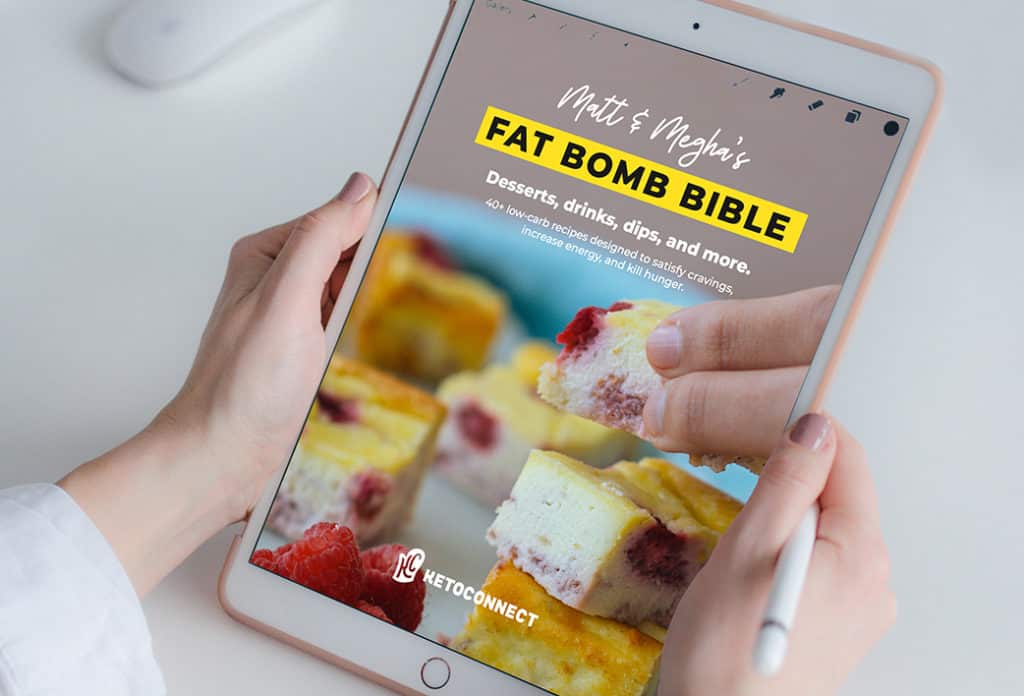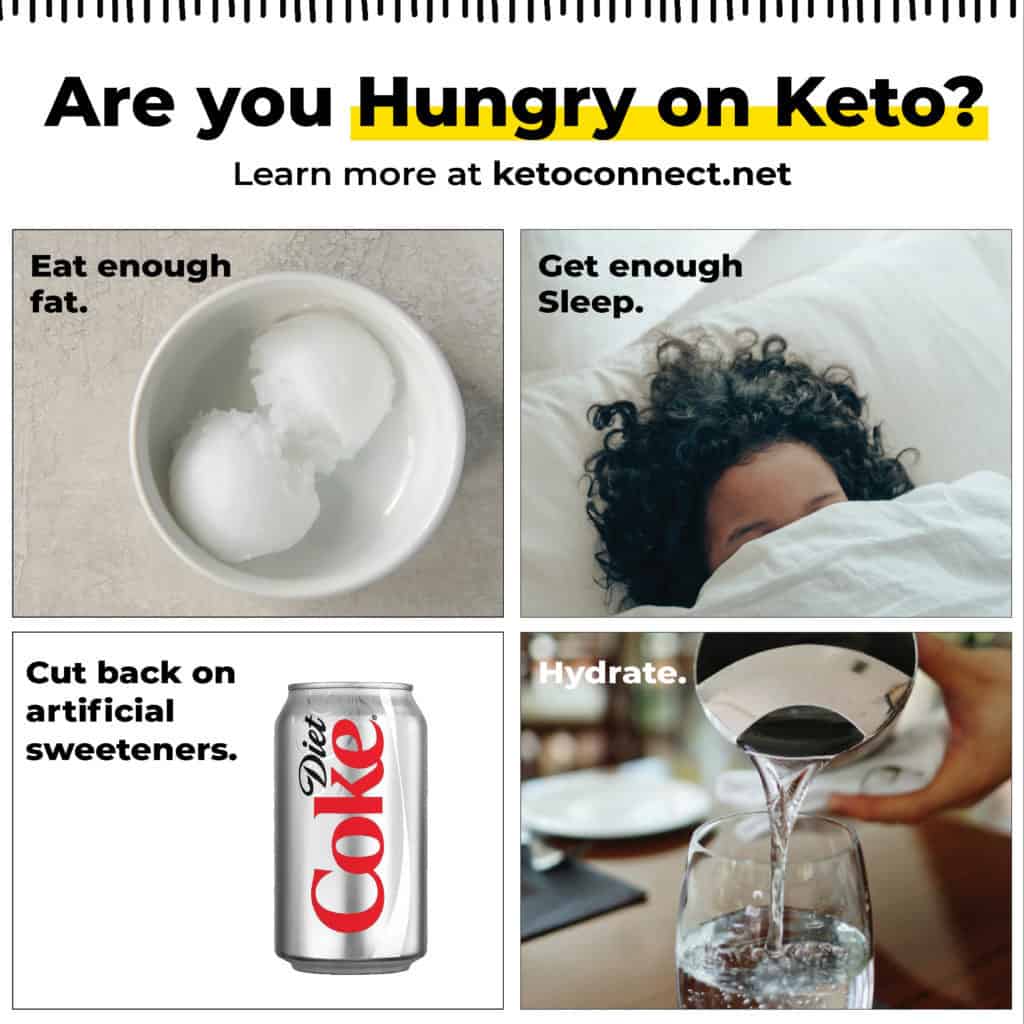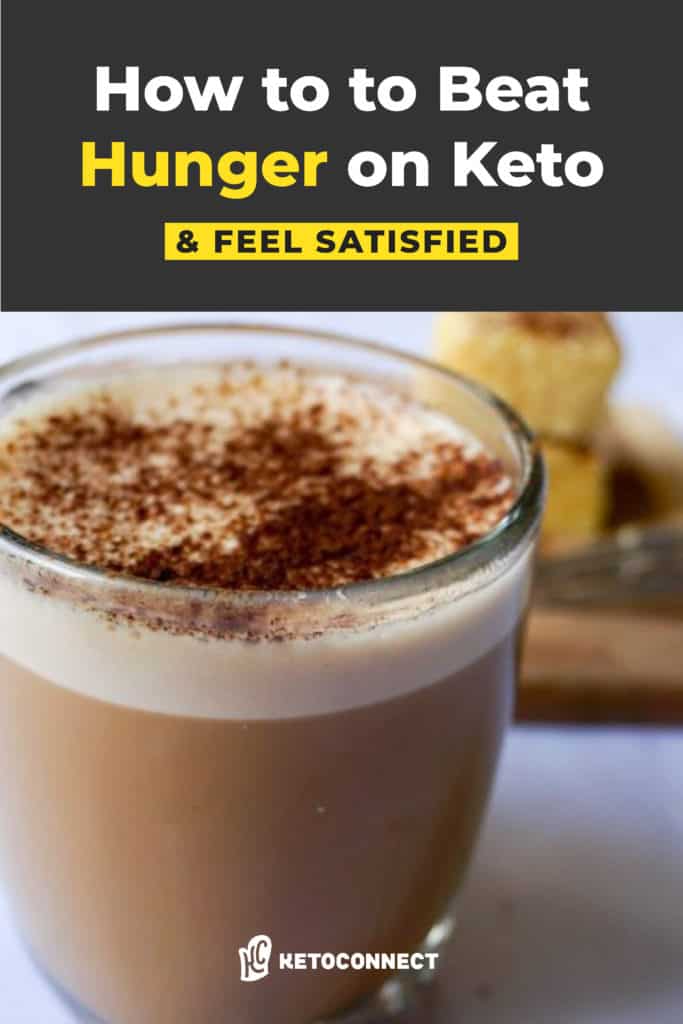Diets don’t mean starving your body — especially the ketogenic diet. Nay-sayers might scoff when they hear the “restrictions” of keto, but anyone who has delved into this delicious way of life knows it is truly satisfying.
You do not have to stay hungry on keto.
After getting over keto flu, years of being in ketosis, and immersing ourselves in the science, we know now that the keto diet doesn’t have to be a quick fad for you. The depressing grind of depriving your body for weight loss is not the right way to live or do keto.
We sat down to figure out the top ways to explain and combat hunger while eating keto. Here’s what we found.
Eat Enough Fat
The keto diet at its core is low carb, moderate protein, and high fat. Many people focus on the restrictive part of the diet when they first start out and neglect to increase their fat intake.
In a state of ketosis, ketones are converted from fat and become our body’s main source of fuel. So, you will feel extremely hungry on keto unless you get your daily macronutrients.
Daily goals for calculating macros should be:
- Less than 20 grams net carbs
- Between 0.6 and 1 gram of protein per pound of lean body mass
- Over 70% of your daily calories from fat
This is an example of a keto dieter’s 2000 calorie breakdown:
- 80 calories / 20 grams of net carbs
- 320 calories / 80 grams of protein
- 1200 calories / 133 grams of fat
Make sure to read our guide on what happens if you don’t eat enough fat on keto.
Bulletproof Coffee
Start your day off with fat in your coffee! If you have an unashamed coffee habit like we do, then adding fat in with your morning cup of joe should be a no brainer. The base recipe is to blend together:
- 12 oz coffee
- 2 tbsp butter
- 1 tbsp MCT oil

Add a tasty collagen coffee creamer for even more benefits that curb being hungry on keto.
Fat Bombs
Fat bombs are the secret to indulging on the keto diet. These treats are not just empty calories. Cacao butter, protein powder, and MCT oil provide your body with macro boosting satiety.

We came up with a recipe that yielded the most versatile and best keto fat bombs that are conveniently shelf stable. You can customize and add anything to our recipe to make it your own.
- Cookies and Cream Fat Bombs
- Shelf Stable Fat Bombs
- Cookie Dough Keto Fat Bomb
- Mini Brownie Bite Fat Bomb
- Snickers Fat Bombs
- Almond Joy Fat Bombs
- Coconut Fat Bombs
Add Butter to Veggies
Veggies taste great soaked in butter and on this diet it’ll add healthy fats that help signal your body you are full.
We strongly believe and science shows that mainly consuming fats high in omega-3s (grass-fed butter, other animal fats, and olive oil) — as opposed to omega-6 fats (vegetable oils such as soybean, canola, and sunflower) — reduce all-body inflammation and contribute to better overall health.
Don’t Deprive Yourself
This high fat, low carb diet can be an effective lifestyle for those who want to go the distance, but don’t short yourself. A big part of success and not always being hungry on keto is to give your body plenty of food to feel full.
Don’t stress about short-term excess body fat. You are changing your health for the long run. Results will come, but only if you feel satiated enough to keep going. So, eat an extra avocado or fat bomb. In the end, your body will thank you.
Cut Back on Artificial Sweeteners
It’s super easy to turn to artificial sweeteners when cutting out a lot of sugar. With their toothsome ability to transform food without spiking blood sugar, it makes sense looking from the outside.
But for many, these sickly sweet substitutes just give the body false hope and leave them craving the real deal.
We advise going a whole week without sugar substitutes and adding one back in to a treat that will test your body’s reaction. Be mindful of what you eat and how it affects you mentally and physically.
Get Enough Sleep
Did you know that the amount of sleep you get can determine your appetite? Sleep deprivation is connected to overeating. There are two hunger-regulating hormones whose production is affected by the amount of sleep you get each night.
Ghrelin levels rise and leptin levels fall when your body experiences less than optimal sleep. This leads to an increase in appetite and cravings for food. Raised ghrelin levels also stimulate fat production and body growth.
So, get the recommended 7-9 hours of sleep every night and try using a sleep app to measure your night’s rest.
Lots of people have found mouth tape increases the quality and duration of their sleep. For a ton of us, the answer is as simple as disconnecting from devices an hour before bed. The blue light emitted from most modern electronics interrupts our circadian rhythm.
If you are hungry on keto, a good night’s reset is what your body might actually be craving.
Too Many Protein or Carb Snacks
With all of the delicious keto-friendly snacks out there, it’s convenient to grab something in the pantry and forget to track it in your macros. Protein or carb intake can creep up without us even realizing we are jeopardizing our dieting. Track everything!
If you feel the need to get control over snacking, try implementing a keto meal plan and pre-measure macro friendly snacks for your day. Some people enjoy intermittent fasting or maybe need to drink a glass of water to fill the void.
Drink More Water
We’ve all been there…You wake up, brush your teeth, and immediately realize your stomach is growling.
After a significant time on keto, you might find that those hunger pains are mostly a thing of the past. But especially as you’re getting started, those might be more of a signal of thirst than hunger.
One study of healthy adult men found that drinking water before a meal actually expanded the stomach enough to reduce hunger. The people in the study actually ate less for the meal right after they water-loaded.
Different individuals’ water needs vary, but it’s a good idea to aim for about half your bodyweight in ounces per day. When you’re feeling hungry but it’s not mealtime, try drinking 16-24 ounces of water, waiting about 15 minutes, and determine whether or not you still want to eat.

Try Keto-Friendly, Appetite-Suppressing Foods & Drinks
If you’re feeling hungry all the time and know you’re getting plenty of calories, try adding some specific items to your pantry that are known to reduce hunger. These include:
Exercise
Exercising is one great way to support weight loss efforts, but it’s also beneficial if you want to stop feeling hungry on keto. Multiple pieces of published research support the idea that exercise suppresses the production of the hunger hormone ghrelin while increasing production of compounds that help you feel full, like PPY, GLP-1, and PP.
Change Your Mindset
You can eat bacon, you can eat cheese, and you can even eat bacon-wrapped cheese. Don’t fall into the trap of focusing on all the foods you can’t eat. Instead, focus on the positive. Motivation and planning increases the likelihood of success.
The grass always looks greener in the other pasture. Once you adjust to keto, you’ll find a plethora of savory fuel sources and never want to go back to tasteless Atkins snacks or low-fat fad foods.
In Summary
- Eat plenty of fat with:
- Bulletproof coffee
- Fat bombs
- Grass fed butter on vegetables
- Artificial sweeteners can increase your sugar cravings.
- The amount of sleep you get correlates to appetite the next day.
- Watch idle snacking and find a discipline that encourages purposeful eating.
- Look on the bright side. You have so many options to keep from being hungry on keto and all of this clean eating is changing your body for the better!
Sources
- Paoli, A., Rubini, A., Volek, J. S., & Grimaldi, K. A. (2013). Beyond weight loss: a review of the therapeutic uses of very-low-carbohydrate (ketogenic) diets. European journal of clinical nutrition, 67(8), 789. Full Text: https://www.ncbi.nlm.nih.gov/pmc/articles/PMC3826507/
- Patterson, E., Wall, R., Fitzgerald, G. F., Ross, R. P., & Stanton, C. (2012). Health implications of high dietary omega-6 polyunsaturated fatty acids. Journal of nutrition and metabolism, 2012. Full Text: https://www.ncbi.nlm.nih.gov/pmc/articles/PMC3335257/
- Yang, Q. (2010). Gain weight by “going diet?” Artificial sweeteners and the neurobiology of sugar cravings: Neuroscience 2010. The Yale journal of biology and medicine, 83(2), 101. Full Text: https://www.ncbi.nlm.nih.gov/pmc/articles/PMC2892765/
- Prinz, P. (2004). Sleep, appetite, and obesity—what is the link?. PLoS medicine, 1(3), e61. Full Text: https://www.ncbi.nlm.nih.gov/pmc/articles/PMC535424/
- Hatori, M., Gronfier, C., Van Gelder, R. N., Bernstein, P. S., Carreras, J., Panda, S., … & Furukawa, T. (2017). Global rise of potential health hazards caused by blue light-induced circadian disruption in modern aging societies. npj Aging and Mechanisms of Disease, 3(1), 1-3. Full Text: https://www.ncbi.nlm.nih.gov/pmc/articles/PMC5473809/
- Corney, R. A., Sunderland, C., & James, L. J. (2016). Immediate pre-meal water ingestion decreases voluntary food intake in lean young males. European journal of nutrition, 55(2), 815-819. Abstract: https://www.ncbi.nlm.nih.gov/pubmed/25893719
- Mansour, M. S., Ni, Y. M., Roberts, A. L., Kelleman, M., RoyChoudhury, A., & St-Onge, M. P. (2012). Ginger consumption enhances the thermic effect of food and promotes feelings of satiety without affecting metabolic and hormonal parameters in overweight men: a pilot study. Metabolism, 61(10), 1347-1352. Full text: https://www.ncbi.nlm.nih.gov/pmc/articles/PMC3408800/
- Gout, B., Bourges, C., & Paineau-Dubreuil, S. (2010). Satiereal, a Crocus sativus L extract, reduces snacking and increases satiety in a randomized placebo-controlled study of mildly overweight, healthy women. Nutrition research, 30(5), 305-313. Abstract: https://www.ncbi.nlm.nih.gov/pubmed/20579522
- Alkhatib, A., & Atcheson, R. (2017). Yerba Mate (Ilex paraguariensis) metabolic, satiety, and mood state effects at rest and during prolonged exercise. Nutrients, 9(8), 882. Full text: https://www.ncbi.nlm.nih.gov/pmc/articles/PMC5579675/
- Schubert, M. M., Irwin, C., Seay, R. F., Clarke, H. E., Allegro, D., & Desbrow, B. (2017). Caffeine, coffee, and appetite control: a review. International journal of food sciences and nutrition, 68(8), 901-912. Abstract: https://www.ncbi.nlm.nih.gov/pubmed/28446037
- Greenberg, J. A., & Geliebter, A. (2012). Coffee, hunger, and peptide YY. Journal of the American College of Nutrition, 31(3), 160-166. Abstract: https://www.ncbi.nlm.nih.gov/pubmed/23204152
- Schubert, M. M., Sabapathy, S., Leveritt, M., & Desbrow, B. (2014). Acute exercise and hormones related to appetite regulation: a meta-analysis. Sports medicine, 44(3), 387-403. Abstract: https://www.ncbi.nlm.nih.gov/pubmed/24174308
- Milne, S., Orbell, S., & Sheeran, P. (2002). Combining motivational and volitional interventions to promote exercise participation: Protection motivation theory and implementation intentions. British journal of health psychology, 7(2), 163-184. Abstract: https://www.ncbi.nlm.nih.gov/pubmed/14596707


